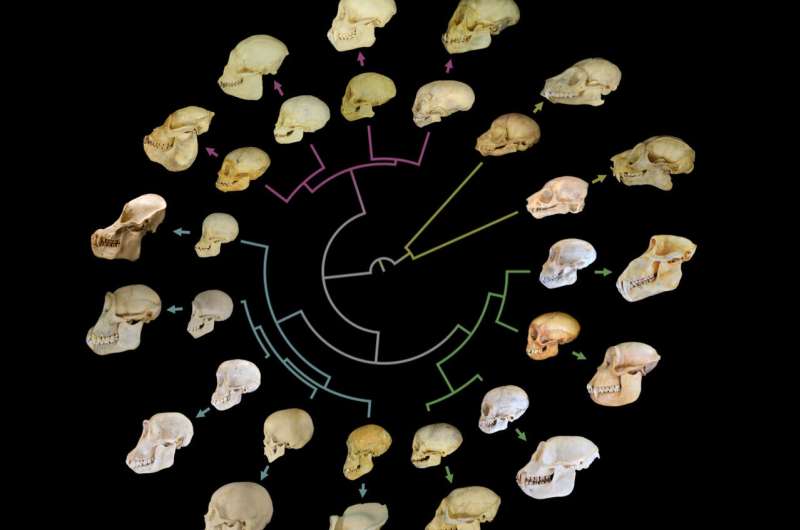A study of skull growth and tooth emergence reveals that timing is everything

Six, 12, and 18. These are the ages that most people get their three adult molars or large chewing teeth towards the back of the mouth. These teeth come in at a much later age than they do in our closest living relative, the chimpanzee, who get those same adult molars at around three, six, and 12 years old. Paleoanthropologists have wondered for a long time how and why humans evolved molars that emerge into the mouth at these specific ages and why those ages are so delayed compared to living apes. Scientists at the University of Arizona and Arizona State University unveil a study in Science Advances this week that they think has finally cracked the case.
Humans are unusual primates. We are highly intelligent, extremely social, remarkably resourceful, able learners, skilled teachers, and as a result, a remarkable evolutionary success story. A key aspect of our biology allowing these components of the human experience to evolve is our unique “life history,” or the overall pace of life, including how fast we grow, how long we are dependent on mothers for nutritional support, how long it takes us to reach sexual maturity, and how long we live. Amazingly, clues to most of these components of our human biology are connected with our teeth.
The one dental feature intimately associated with the pace of growth and life history is the ages at which our adult molars cut through the gumline. For many decades, evolutionary anthropologists have leveraged the very tight relationship—which exists across all primates—between the pace at which these adult molars emerge into the mouth with the overall pace of life. Modern humans, for instance, grow up incredibly slowly, have a very long and protracted life history, and emerge their adult molars very late in life, later than any other living or extinct primate.
“One of the mysteries of human biological development is how the precise synchrony between molar emergence and life history came about and how it is regulated,” said Halszka Glowacka, lead author and assistant professor at the University of Arizona, College of Medicine-Phoenix.
Glowacka and paleoanthropologist Gary Schwartz, a researcher with the Institute of Human Origins and professor in the School of Human Evolution and Social Change, published their study this week that provides the first clear answer—it is the coordination between facial growth and the mechanics of the chewing muscles that determines not just where but when adult molars emerge. This delicate dance results in molars coming in only when enough of a “mechanically safe” space is created. Molars that emerge “ahead of schedule” would do so in a space that, when chewed on, would disrupt the fine-tuned function of the entire chewing apparatus by causing damage to the jaw joint.
For the study, Glowacka and Schwartz created 3D biomechanical models of skulls, including the attachment positions of each major chewing muscle, throughout the growth period in nearly two dozen different species of primates ranging from small lemurs to gorillas. When combined with details about the rates of jaw growth in these species, their integrative models revealed the precise spatial relationship and temporal synchrony of each emerging molar within the context of the growing and shifting masticatory system.
The authors note that this research establishes two things—it convincingly demonstrates that it is the precise biomechanical relationship between growing faces and growing chewing muscles that results in the tight and predictive relationship between dental development and life history, and it reveals that our species’ delayed molar emergence schedules are a result of the evolution of overall slow growth coupled with short jaws and retracted faces—faces situated directly beneath our braincase.
Their study revealed that the combination of how fast jaws grow with how long or protruding jaws will ultimately become in adults determines the timing of when molars will emerge. Modern humans are special among primates given our prolonged growth profiles and our retracted faces with short dental arcades.
“It turns out that our jaws grow very slowly, likely due to our overall slow life histories and, in combination with our short faces, delays when a mechanically safe space—or a ‘sweet spot’ if you will—is available, resulting in our very late ages at molar emergence,” said Schwartz.
“This study provides a powerful new lens through which the long-known linkages among dental development, skull growth and maturational profiles can be viewed,” said Glowacka.
The researchers plan to apply their model to fossil human skulls to answer questions about when slowed jaw growth and delayed molar emergence first appeared in our fossil ancestors.
They also realize that the approach taken in this study could have implications for clinical dentistry. Because molars do not emerge until a point when enough facial growth has occurred and the sweet spot appears, “the finer details of the model could be explored in more samples to help understand the phenomenon of impacted wisdom teeth in humans,” noted Glowacka.
Researchers reconstruct the precise bite of an early mammal
A biomechanical perspective on molar emergence and primate life history, Science Advances (2021). DOI: 10.1126/sciadv.abj0335
Citation:
A study of skull growth and tooth emergence reveals that timing is everything (2021, October 6)
retrieved 6 October 2021
from https://phys.org/news/2021-10-skull-growth-tooth-emergence-reveals.html
This document is subject to copyright. Apart from any fair dealing for the purpose of private study or research, no
part may be reproduced without the written permission. The content is provided for information purposes only.
For all the latest Science News Click Here
For the latest news and updates, follow us on Google News.

